Part 1: The problem
The United States creates 250 million tons of trash annually, of which 35.7 million tons are plastic (US EPA). Of the country’s total waste, only 25.7% gets recycled, and the remaining 52.6% gets thrown into landfills, 8.9% is composted, and 12.8% is incinerated. In 2018, only 8.7% of the total plastic waste in the United States got recycled. Meanwhile, landfills received 27 million tons of plastic waste, and landfills in the United States are beginning to reach their maximum capacity (US EPA).
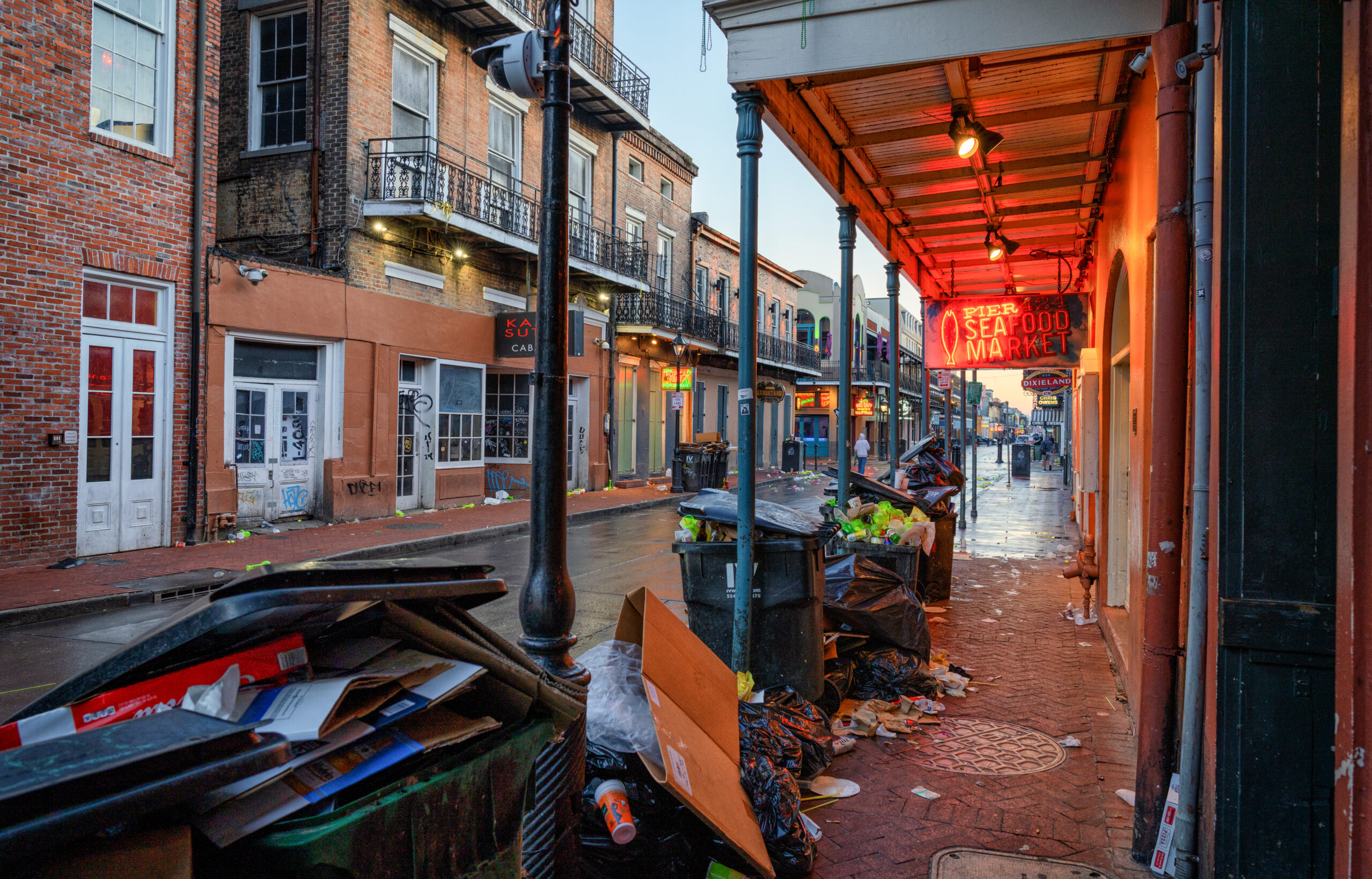
Trash along Bourbon Street in New Orleans, Louisiana, early on a Sunday morning.
As landfills begin to fill up, they pose adverse consequences to nearby communities as their soil and groundwater become contaminated due to toxins from methane. They also release other harmful toxic gasses that harm the health of residents residing in nearby communities and produce odors, unpleasant views, and increase pest infestations. These factors decrease the value of adjacent land by 12.9%. Communities neighboring landfills tend to be minority and low-income communities that are disproportionately affected as they inhale the toxins. Toxins emitted from landfills include methane and carbon dioxide, which puts them at high risk of suffering from adverse health conditions.
Landfills are also damaging to the environment due to leachate, toxins, and greenhouse gasses. Leachate is formed from waste breakdown and water filtering through the waste, causing toxic chemicals to leak and contaminating nearby communities’ soil and water supplies. The biggest environmental threat from landfills is the greenhouse gasses emitted into the environment when oxygen is removed and methane is released. Methane, a gas that is 86 times more potent than carbon dioxide, poses the biggest threat to our environment as it advances climate change.
One way to reduce waste and its adverse consequences are to recycle. However, many cities across the United States do not have adequate recycling programs to make recycling easy and accessible to residents. New Orleans is widely known for its party atmosphere, including Bourbon Street, Mardi Gras, and its open container law, enabling this party culture throughout the city. New Orleans Municipal Code Sec. 54-404 allows anyone to carry an open container. Containers are not allowed to be made out of glass, leading vendors to utilize plastic or styrofoam cups, further contributing to the city’s plastic pollution.
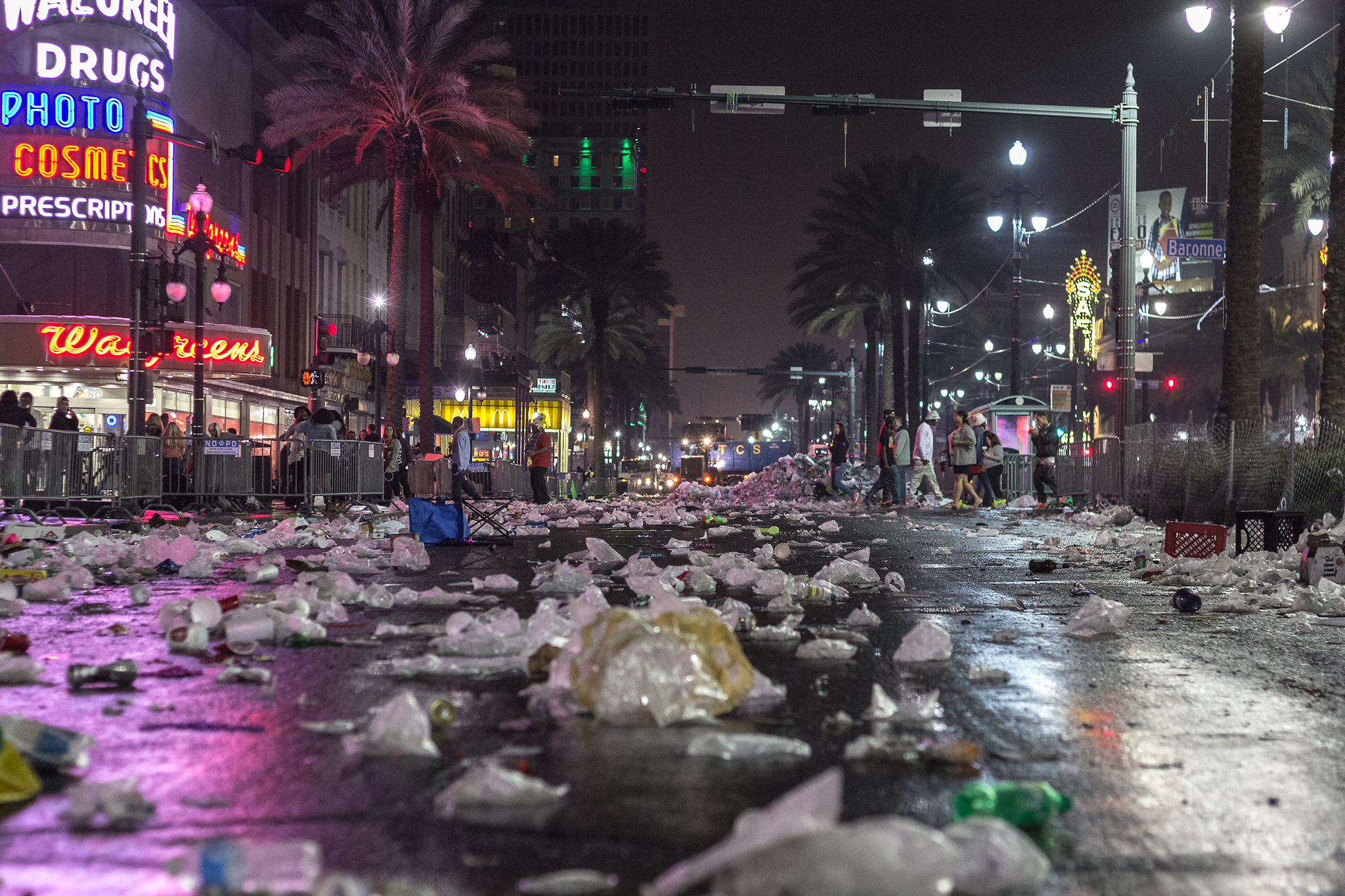
Downtown New Orleans, Mardi Gras aftermath
Another significant contributor is Mardi Gras beads. Forty-five million pounds of plastic in Mardi Gras festivities are imported to New Orleans annually (Boudreaux). In 2020, 1,200 tons of waste were collected from the city’s biggest party. Forty-six tons of garbage consisted of 93,000 plastic beaded Mardi Gras necklaces. These beads are thrown for residents and tourists to catch and wear during the city-wide celebration, though most end up on the streets, storm drains, and in the Mississippi River. Even the beads taken home tend to end up in the trash and later in a landfill.
Though plastic pollution is a prevalent issue in New Orleans, the real problem lies in the city’s lack of recycling programs for residents that would undoubtedly assess or aid the issue of plastic pollution. From 2017 to 2022, the City of New Orleans only recycled 3.1%of the waste left out by residents for curbside pickup. This only accounts for residential waste from residents that are eligible for the city’s recycling program, leaving the accounted 97% and a large sum of the rest of the waste that was not accounted for, filling up the Municipal Solid Waste Landfill, River Birch Landfill Avondale.
To obtain a recycling bin in New Orleans, residents must request one from the city and will only get one if they are eligible. The requirements to be eligible for the city’s recycling curbside pickup program include small businesses, single-family houses, multi-family complexes, and properties that have four units or fewer. Bars, restaurants, and hotels are not eligible for the city’s sanitation program and must hire a private company if they wish to recycle. Residents who are not eligible for the city’s recycling program and want to recycle must bring their recycling to a Recycling Drop-off center or hire a private company.
Residents usually do not want to exert the extra effort of requesting a recycling bin, going to the drop-off locations, or spending the extra money on a private recycling company, especially since the city does not require them to recycle. Only about 50% of the eligible residents in New Orleans participate in the recycling program. However, even for eligible people, the city’s recycling program has limitations, as the city only allows plastics #1 and #2, two of the seven types of recyclable plastics. Around 25-40% of the items left for recycling are sent to landfills as they are believed to be contaminated. The city’s recycling rate is one-tenth of the US, and Louisiana is the second worst out of the country’s Greenest States.
Part 2: Data-driven solution
The solution to the recycling issue in New Orleans is to enforce a strict recycling program throughout the city that is mandatory for all residents. San Francisco, California, has the highest diversion rate, standing today at 80%, of all the cities in the United States (EPA).
In 2003, San Francisco’s 52% of the city’s total waste came from landfills. However, they sought to become zero-waste by 2020 and began developing a three-stream waste management solution to help them achieve this goal. By 2007, San Francisco was still sending 618,000 tons of waste to landfills; this included 36% of compostable waste and 31% of recyclable waste. In 2006, though seemingly high, their diversion rate stood at 67%.
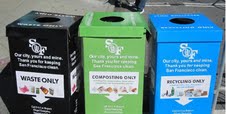
San Fransisco’s waste, compost, and recycling event bins
In 2009, the city passed the Mandatory Recycling and Composting Ordinance, which requires residents and companies to separate their trash, recyclables, and compostables. This was the first local municipal ordinance in the United States that required residents to separate their waste. Rather than just having one blue recycling bin, San Francisco provides its residents with three separate bins, blue for recycling, green for compost, and black for trash, that compose its three-stream citywide residential and commercial recycling program (EPA). This system allows 80% of waste to be diverted from landfills, either composted or recycled, making landfills nearly obsolete.
Seeking to have zero waste by 2020, the San Francisco government set forth The Checkout Bag Charge and Recyclable or Compostable Pre-Checkout Bag Ordinance, Food Service Waste Reduction Ordinance, and the Construction and Demolition Ordinance (SF Environment). The Compostable Pre-Checkout Bag Ordinance required retail stores to promote customers to use reusable bags by charging them 0.25 cents per bag at checkout. It also banned single-use plastic bags to ensure that retail stores and restaurants provided customers with bags that could be recycled or composted. The city also banned restaurants from using plastic or styrofoam to-go containers and required that construction companies have an approved debris recovery plan to decrease the waste production from residents and organizations in the community.
Debbie Raphel, the San Francisco Department of Environment director, states that the idea behind these ordinances and the separation of trash is to incentivize residents and businesses there. To encourage recycling and composting, every resident and company are given a 64-gallon recycling bin, 32-gallon compost bin, and a 16-gallon trash bin. The city ordinance requires garbage collectors to tag containers with incorrectly sorted material. Businesses will receive a fine of up to five hundred dollars if they place trash, recyclables, or compostables in the wrong bind. However, they are rewarded with a 75% discount on trash bills when using the blue or green bins. Residents are fined one hundred dollars for placing waste in the wrong bins.
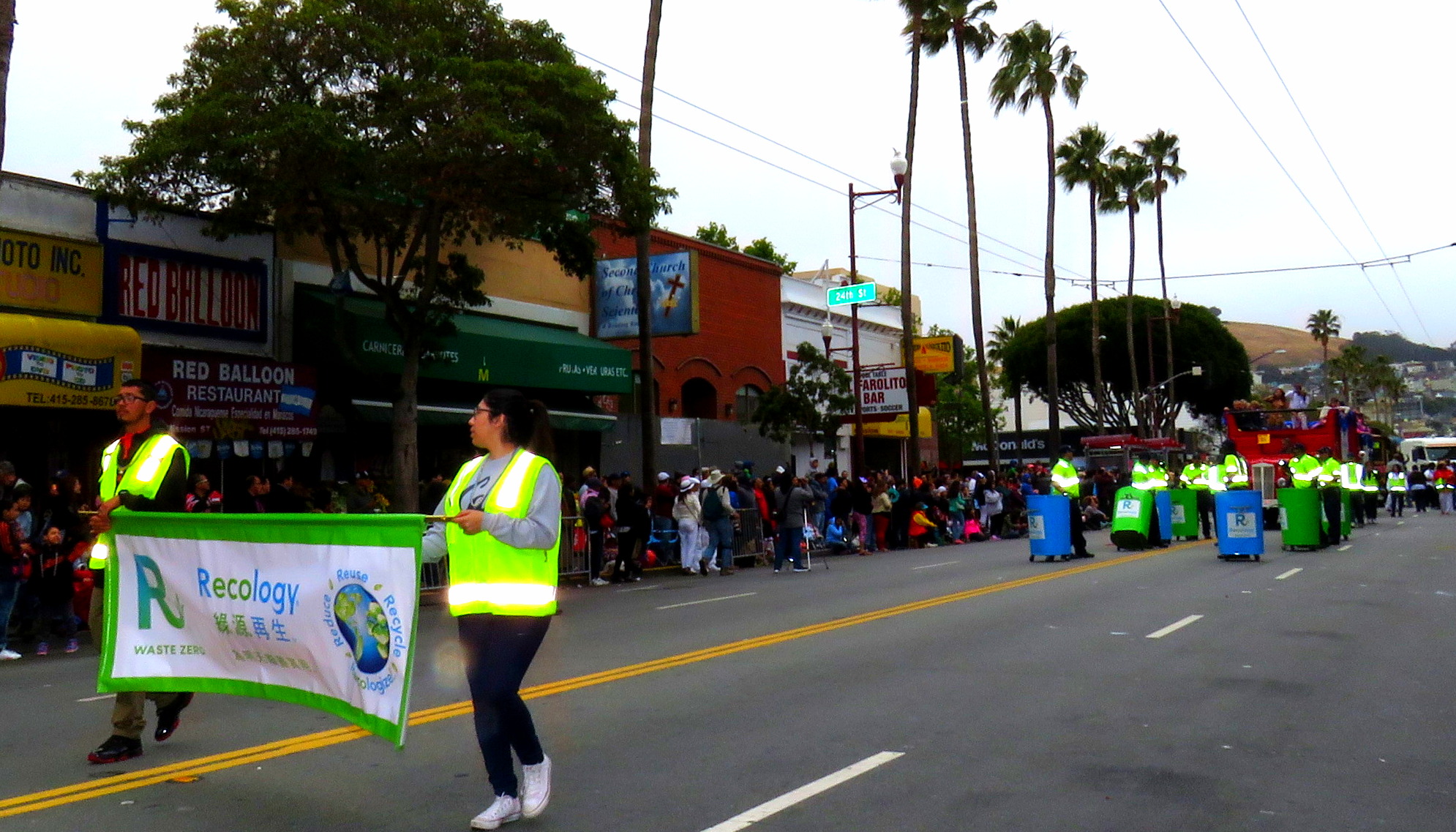
San Francisco Recology Parade
In 2009, after the full implementation of the city’s three-stream waste reduction program, the volume of waste being composted grew from 400 tons to 600 in just one year. San Francisco’s motives for beginning the three-stream solution were to reduce landfill leaks, increase the lifespan of landfills, and decrease the amount of greenhouse gasses released through composting. Their recycling program comes with vast economic savings, reducing the need for mining new metals, saving energy from recycling glass, and not cutting new trees for paper. Between 1996 and 2011, the city estimates avoiding 354,600 tons of methane emissions. Today, the city collects 500 tons of waste every day from the composting bin and diverts 1.5 million tons of recyclable waste from landfills. Additionally, the city’s three-stream solution has created thousands of jobs. The city’s Mayor, Gavin Newsom, reported that the recycling industry produces ten times as many jobs as sending minerals to landfills.
The biggest limitation of San Francisco’s three-stream waste reduction solution is that it requires vast economic investments, costing $300,000 million a year. San Francisco’s waste management industry is a monopoly as Recology, and its subsets are in charge of waste management across the entire city (Silva, Rosano, Stocker, Gorissen, 207). Thus, they profit immensely from their partnership with the San Francisco government. However, an obstacle in their partnership is that Recology workers are not required to look through the trash to ensure that waste is properly separated. The workers are only required to look at the top layer; thus, they will not always receive a fine if someone is recycling improperly. Another limitation of this solution is its time-consuming implementation of the three-stream system. The city had to implement multilingual, photo-rich outreach and education programs, including presentations and door-to-door outreach, school education, and social media campaigns. Recology workers spent two years going to every house and business to ensure that they understood how the waste management system worked, making sure everyone had enough bins and complied with the law.
Part 3: Implementation
Implementing San Francisco’s three-stream waste management solution in New Orleans would significantly decrease waste production and plastic pollution and increase New Orleans’ recycling rate. This solution would require the city government to mimic the actions followed by San Francisco. The city government would have to spend time educating residents on how to recycle, ban single-use plastics/styrofoam, encourage citizens to sign up for the city’s free curbside recycling program and have fines and rewards for those who do and do not recycle properly.
Educating citizens about recycling is an essential part. Some citizens do not realize that if they throw a non-recyclable item in a recycling bin, the bin is considered contaminated, and everything is thrown in the trash. Since the city only recycles plastic #1 and #2, it should show residents how to identify what type of plastic they are discarding and provide each household with an educational program containing a list of what can and cannot be recycled in their area. This would encourage citizens to recycle and ensure that recycling bins are not contaminated and end up being recycled.
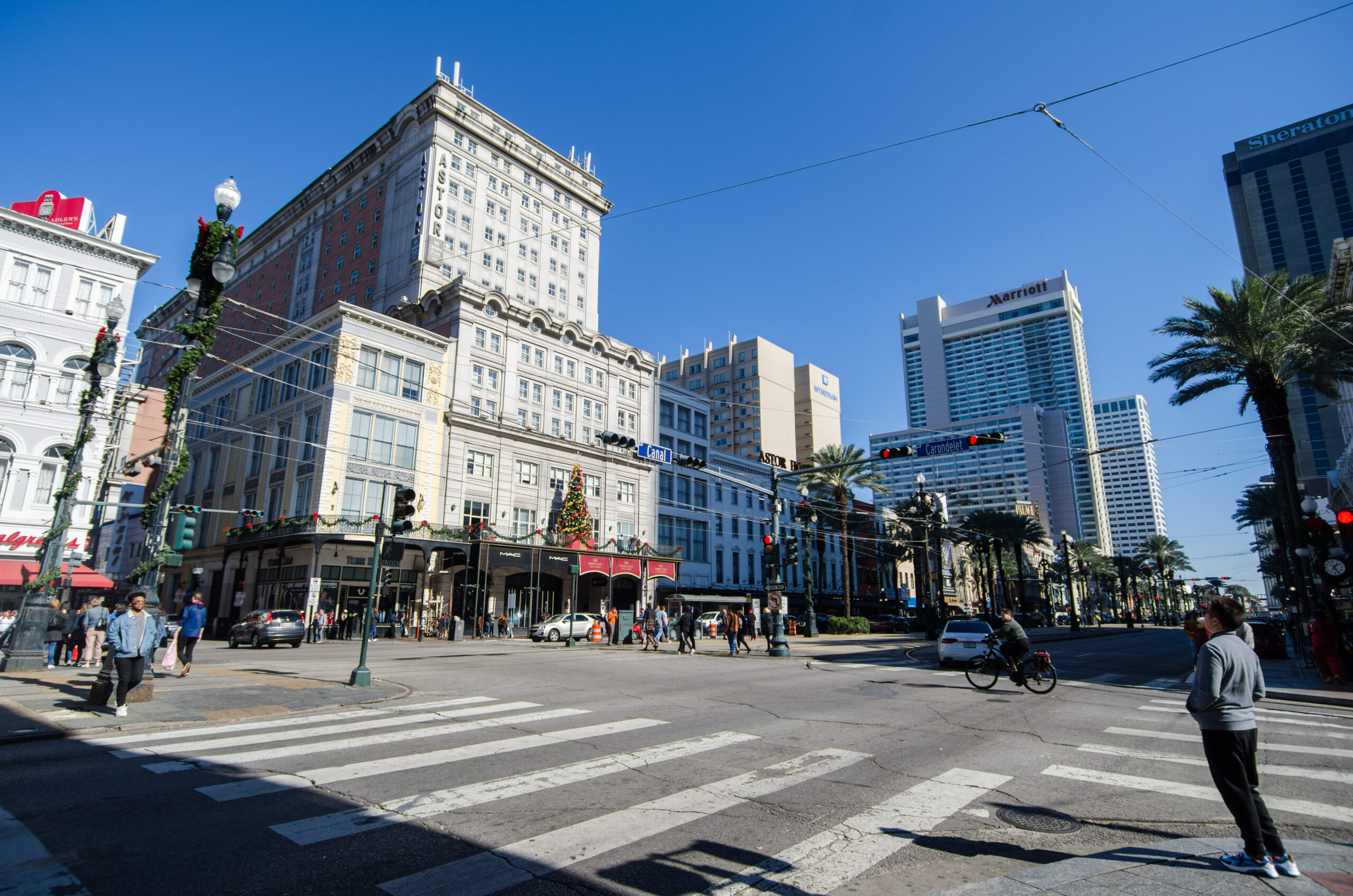
A clean New Orleans, Canal Street & Carondelet Street
Additionally, the city should follow San Francisco’s lead and provide all its residents with recycling bins and including all areas in the city, rather than only providing them to people in eligible areas who request them. Getting citizens to recycle requires making it easy for them to do so. Most residents do not want to make the extra effort of driving their recyclables to drop-off locations. The city would also have to implement a single-use plastic and styrofoam ban to reduce plastic pollution, seeing as the city cannot recycle most plastics. Finally, once the recycling program is more developed, the city government should implement fines and rewards for those who do not and do recycle adequately.
This solution’s difficulty is that New Orleans does not have sufficient funding to create such thorough and intensive educational programs for recycling and waste management implementation. Banning single-use plastics would also be an obstacle due to the city’s party culture, as many might not be willing to give up their to-go cups and Mardi Gras Beads. Additionally, unlike San Francisco, the city does not have partnerships with all its Waste Management companies, making it hard for the city to implement fines and rewards for those who recycle.
However, seeing how San Francisco’s implementation of its three-stream solution was a vast success, implementing it in New Orleans would undoubtedly work. San Francisco consists of 884,108 residents and produces 900,000 tons of waste annually. New Orleans’ population, on the other hand, is just under half of San Francisco’s, with 387,564 residents, and every Mardi Gras season alone produces 900 tons of waste in just one week.
Most citizens wish to recycle and create a cleaner and greener New Orleans. However, the issue is that recycling is not easily accessible to many. Educating citizens and giving them the means to recycle would increase the city’s recycling rates, even if the results are not as high as San Francisco’s. By not having to go the extra mile, citizens would be more prone to recycling. Additionally, being fined when one does not recycle and rewarded with discounts when one would be a great incentive for many to recycle and, most importantly, to recycle appropriately.
References
Angie Silva, Michele Rosano, Laura Stocker, Leen Gorissen. “From waste to sustainable materials management: Three case studies of the transition journey.” Waste Management, Volume 61 (2017): Pages 547-557, ISSN 0956-053X, https://doi.org/10.1016/j.wasman.2016.11.038.
Boudreaux, Anne. “Throw Me Something Else, Mister: A Solution to the Harmful Effects of Mardi Gras Bead Pollution.” LSU J. Energy L. & Resources 9 (2021): 229.
San Francisco Environment. “Checkout Bag Charge and Recyclable or Compostable Pre-Checkout Bag Ordinance.” San Fransisco Department of the Environment (2022). Web.
United States Environmental Protection Agency. “National Overview: Facts and Figures on Materials, Wastes and Recycling” United States Environmental Protection Agency (2018). Web.
This piece was edited by Jiayi Xu as part of Professor Kelley Crawford’s Digital Civic Engagement course at Tulane University.
 NOLAbeings Multimedia artist Claire Bangser created NOLAbeings as a portrait-based story project that marries...
NOLAbeings Multimedia artist Claire Bangser created NOLAbeings as a portrait-based story project that marries...  Voodoo in New Orleans: Reviving history: New Orleans fortune telling This article takes a deep dive into the history of Voodoo in New Orleans, its hybridization with Catholicism, and its present-day place in the city's culture. The author visits fortune-tellers in the French Quarter, using their guidance as a tool for introspection rather than a deterministic predictor of the future. Through her experiences in New Orleans, the author feels a mystical connection to both the past and the future.
Voodoo in New Orleans: Reviving history: New Orleans fortune telling This article takes a deep dive into the history of Voodoo in New Orleans, its hybridization with Catholicism, and its present-day place in the city's culture. The author visits fortune-tellers in the French Quarter, using their guidance as a tool for introspection rather than a deterministic predictor of the future. Through her experiences in New Orleans, the author feels a mystical connection to both the past and the future. 